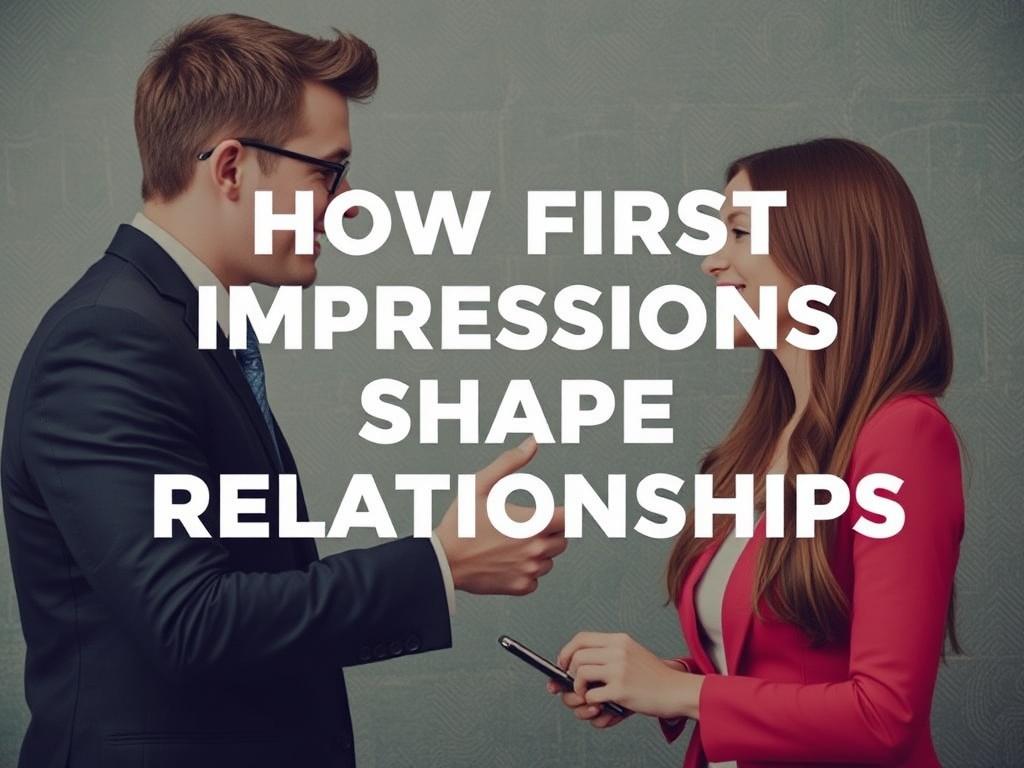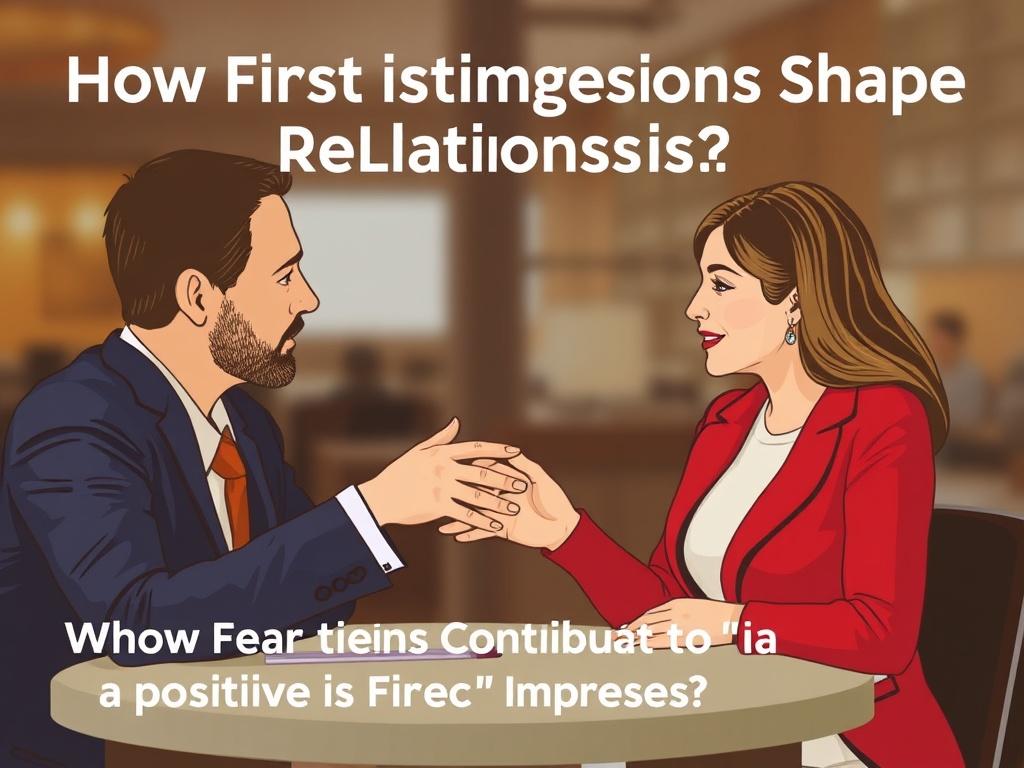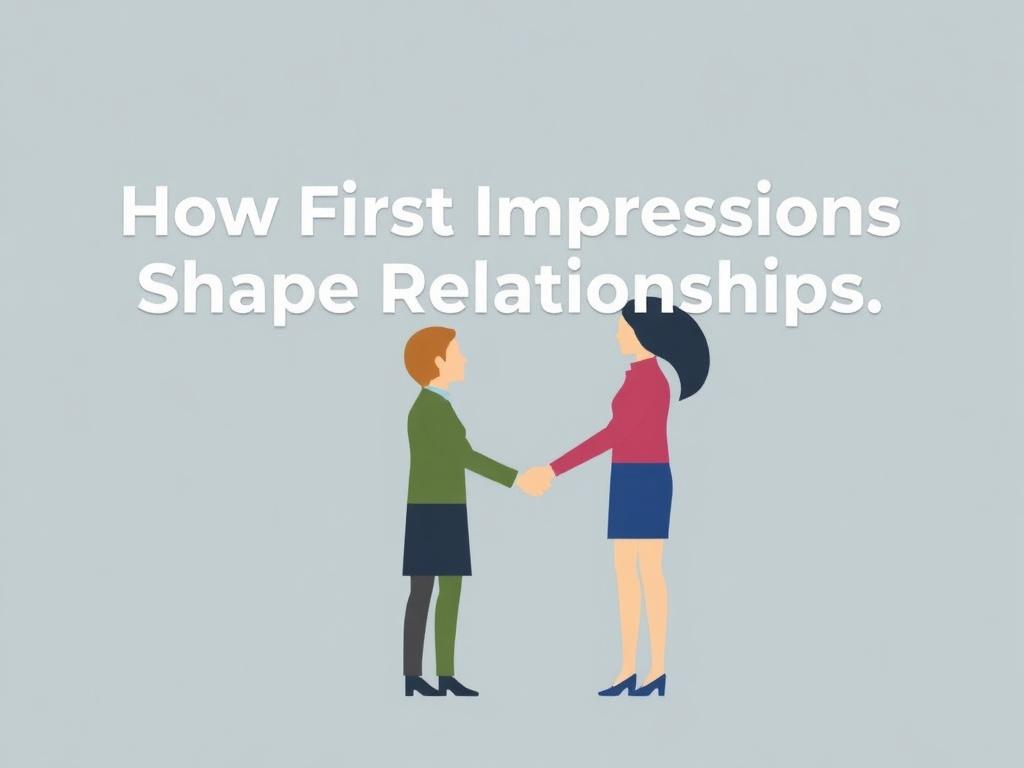When you meet someone for the first time, there’s an invisible thread weaving its way through your interaction—a thread that can pull you closer or push you apart. This thread is none other than the first impression. It might sound a little surprising to say that those first few seconds or minutes of meeting someone can shape the entire trajectory of a relationship, but it’s true. Whether it’s a professional connection, a friendship, or a romantic relationship, first impressions act as powerful gatekeepers. They influence how we perceive others and often dictate the level of trust, warmth, or skepticism that forms between two people. Understanding how first impressions shape relationships can open doors to more meaningful connections by helping us recognize the subtle, unconscious signals that we send and receive.
First impressions form rapidly—some studies suggest within the first seven seconds—and they stick around far longer than we realize. These impressions shape our expectations and behaviors, often without us being overtly aware. Imagine walking into a room full of people and spotting one face that immediately feels warm and trustworthy. That positive feeling primes you to be more open and collaborative with that person later on. Conversely, a negative first impression can create barriers that are difficult to overcome, no matter how much effort is put into changing perceptions afterward. This phenomenon underscores the importance of how we present ourselves and interpret others during those initial moments of interaction.
The Psychology Behind First Impressions

First impressions aren’t just about judging appearances—they stem from a complex cocktail of psychological processes. Our brains are wired to quickly categorize new information, a mechanism rooted in our survival instincts. Early humans needed to decide swiftly whether someone posed a threat or was a potential ally. Today, this translates into rapid assessments based on physical appearance, body language, tone of voice, and even subtle social cues that often are processed unconsciously.
One key concept is the «halo effect,» where a single positive trait—like an attractive smile or confident posture—can cause the brain to attribute other positive qualities to a person, such as intelligence or kindness. Similarly, the «horn effect» occurs when a single negative feature colors our overall perception adversely. These biases mean that first impressions are not always accurate, yet they strongly influence how relationships begin and develop. It’s also interesting to note how cultural background and personal experiences shape the way we interpret these cues, further complicating the delicate dance of forming new connections.
How First Impressions Influence Different Types of Relationships
Although first impressions impact all kinds of relationships, the stakes and manifestations can vary depending on the context. Let’s break down three main areas where first impressions play a critical role:
- Professional Relationships: In the workplace, first impressions affect hiring decisions, teamwork, leadership credibility, and networking opportunities. Confidence, professionalism, and approachability become major factors in deciding if someone is worth collaborating with or trusting in a professional setting.
- Friendships: When building friendships, warmth, empathy, and shared values often come to the forefront. A positive first impression encourages people to invest emotionally, while a poor one may lead to missed chances for connection and support.
- Romantic Relationships: The romantic realm arguably feels the most palpable impact of first impressions. Physical attraction, perceived kindness, and emotional availability can strongly influence whether individuals want to pursue the relationship further.
In all these cases, the initial impression serves as a foundation upon which all future interactions are built. It creates expectations, both realistic and sometimes misplaced, that guide the progression of the relationship.
What Factors Contribute to a Positive First Impression?

Making a memorable and positive first impression isn’t about gimmicks or putting on a fake persona. Instead, it involves authenticity combined with simple social skills that signal openness, respect, and engagement. Here are some of the key contributors:
| Factor | Description | Impact on Relationship |
|---|---|---|
| Body Language | Open posture, good eye contact, appropriate facial expressions, and relaxed gestures. | Conveys confidence and approachability. Builds trust and reduces perceived barriers. |
| Tone of Voice | Warm, steady, and enthusiastic tone that matches the conversation’s context. | Signals emotional availability and interest. Makes communication easier and more engaging. |
| Appearance | Clean, tidy, and context-appropriate dressing that reflects care for oneself. | Creates perceptions of professionalism, reliability, or compatibility. |
| Listening Skills | Active listening demonstrated through nodding, clarifying, and responsive feedback. | Shows respect and genuine interest, encouraging openness from others. |
| Emotional Intelligence | Ability to sense and respond to others’ emotions appropriately. | Fosters empathy and understanding, which strengthens bonds quickly. |
Understanding these factors can empower anyone to influence first impressions positively and, by extension, the relationships that follow.
The Role of Communication in Shaping First Impressions
Communication goes both ways in shaping the initial perception. It’s not just what you say, but how you say it, and just as importantly, what you don’t say. Silence, pauses, and nonverbal cues can speak volumes. For example, a person who appears distracted or dismissive, even unintentionally, might leave a poor first impression no matter how polished their words are.
When it comes to verbal communication, clarity and authenticity are key. Sharing stories, asking open-ended questions, and mirroring the other person’s energy are subtle ways to build rapport. These acts show that you value the interaction, a crucial ingredient in forming any durable relationship.
First Impressions in the Digital Age
We live in a world where much of our initial contact happens online, whether through social media, dating apps, or professional networks. This shift has complicated the nature of first impressions because now, they’re often based on profiles, photos, or a snippet of text rather than face-to-face interaction.
In digital spaces, the equivalent of body language and tone is conveyed through writing style, response time, and even the way someone curates their online presence. Profiles with clear, friendly photos, well-written bios, and positive interactions tend to create stronger, more favorable first impressions.
However, the lack of physical cues can also lead to misunderstandings or misjudgments. The absence of nonverbal feedback requires individuals to be more intentional with their words and images. Crafting a thoughtful, genuine digital presence is essential since those first virtual impressions can steer relationships toward fruitful connections or dead ends.
Breaking Down Barriers: Can Bad First Impressions Be Revised?
While first impressions are powerful, they are not set in stone. Relationships are dynamic, and people do have the ability to change how others perceive them over time. However, revising a negative first impression often takes more effort and patience than starting with a positive one.
To overcome a bad first impression, consistency is key. By repeatedly demonstrating the qualities that were missed or misjudged initially—such as kindness, competence, or reliability—you slowly chip away at prejudices formed from that first encounter. Open communication and vulnerability can also help by showing authenticity and encouraging mutual understanding.
Here’s a small list of strategies for revising first impressions:
- Apologize if necessary and acknowledge any awkwardness or misunderstanding.
- Show genuine interest in the other person’s thoughts and feelings.
- Be consistent in your behavior and communication over time.
- Seek common ground and shared experiences to rebuild rapport.
- Be patient—changing perceptions doesn’t happen overnight.
This approach makes it clear that while first impressions shape relationships, they don’t have to define them forever.
Why Do First Impressions Matter So Much?
You might wonder why so much time and emotion are invested in those fleeting initial moments. The answer boils down to cognitive efficiency and social survival. Our brains constantly seek to save energy by simplifying complex social worlds. First impressions act as mental shortcuts, enabling quick decisions about how to engage with others.
Moreover, first impressions set the tone for trust and cooperation. If someone makes a positive impact initially, you’re more likely to give them the benefit of the doubt later in the relationship. Conversely, failing to make a good first impression can activate skepticism and defensive attitudes, which can hinder rapport and openness.
In essence, first impressions serve as a social currency. They determine whether doors open or stay closed, influencing not just who we trust or befriend, but also how we collaborate, love, and support one another.
Common Myths About First Impressions
There are many misconceptions circulating about first impressions. Let’s debunk a few common myths:
| Myth | Reality |
|---|---|
| First impressions are always accurate. | They are shaped by biases and incomplete information, so they can be wrong. |
| You can’t change a first impression once it’s made. | While difficult, consistent positive behavior can reshape initial judgments. |
| Only physical appearance matters in first impressions. | Nonverbal cues, communication, and emotional intelligence matter greatly too. |
| First impressions happen in a second or two only. | While initial judgments are fast, they evolve during the first few minutes of interaction. |
Understanding these myths can help us approach first impressions with more nuance and flexibility.
Practical Tips to Make a Great First Impression

Now that we’ve unpacked the psychology and impact of first impressions, here are some actionable tips you can use the next time you meet someone new:
- Dress the Part: Wear clothing appropriate for the setting, reflecting respect and self-care.
- Smile Genuinely: A warm smile can immediately disarm tension and create positive vibes.
- Practice Good Posture: Stand or sit upright but relaxed to convey confidence.
- Make Eye Contact: It shows engagement and honesty but avoid staring to prevent discomfort.
- Be Present: Focus on the moment and your conversation partner, minimizing distractions.
- Listen More Than You Talk: People appreciate being heard—it builds connection.
- Mind Your Tone: Use a friendly, warm voice that matches the context and content of your message.
- Ask Open-ended Questions: This encourages dialogue and reveals genuine interest.
These simple but effective strategies can help you foster positive first impressions that pave the way for meaningful relationships.
The Long-Term Impact of First Impressions on Relationship Quality
It’s one thing to make a good first impression, but it’s another to maintain and build on it for lasting relationship quality. A strong start sets the stage for trust, empathy, and collaboration—all fundamental components for any healthy relationship.
When first impressions are favorable, people tend to show more patience and forgiveness during inevitable conflicts. They’re also more likely to invest emotionally, leading to deeper connections and mutual growth. On the flip side, a shaky first impression can create a pattern of doubt and miscommunication that erodes relationship satisfaction over time.
Here is a summary of how first impressions relate to long-term outcomes:
| Aspect | Positive First Impression | Negative First Impression |
|---|---|---|
| Trust | Develops quickly and tends to deepen | Slow to form, may remain tentative |
| Communication | Open, honest, and frequent | Guarded and limited |
| Conflict Resolution | Collaborative and constructive | Defensive and adversarial |
| Emotional Intimacy | Comfortable and growing over time | Difficult to achieve and sustain |
Clearly, first impressions don’t just color the early phases of relationships—they influence their trajectory in profound ways.
Wrapping It Up: Why Paying Attention to First Impressions Matters
First impressions shape relationships in ways that are both obvious and subtle. They form a social blueprint that influences trust, attraction, and communication patterns. By understanding the psychological mechanisms behind these early judgments, we can learn to be more mindful of our own behaviors and perceptions. Whether in personal or professional spheres, taking the time to make positive first impressions and recognizing their imperfection opens doors to new opportunities and deeper connections. Although they carry weight, first impressions also leave room for growth and change—offering hope that even rocky starts can evolve into strong, lasting relationships. So next time you step into a new interaction, remember: those first few moments matter more than you might think, and how you show up can truly set the tone for everything that follows.
Conclusion
In the grand tapestry of human relationships, first impressions act as the initial threads that bind people together or push them apart. They are quick, powerful snapshots that influence not only how we see others but how others see us. Though they are not infallible and can be reshaped, first impressions nonetheless carry a heavy influence on the quality and longevity of our connections. Recognizing their power encourages us to approach new encounters with awareness and authenticity—fostering an environment in which meaningful, trusting, and fulfilling relationships can flourish. Ultimately, by mastering the art and science of first impressions, we hold the key to unlocking richer social and emotional lives.




















